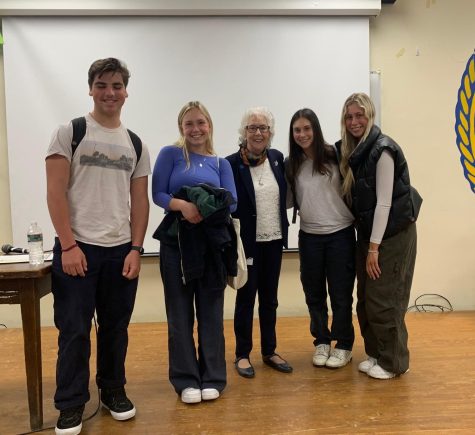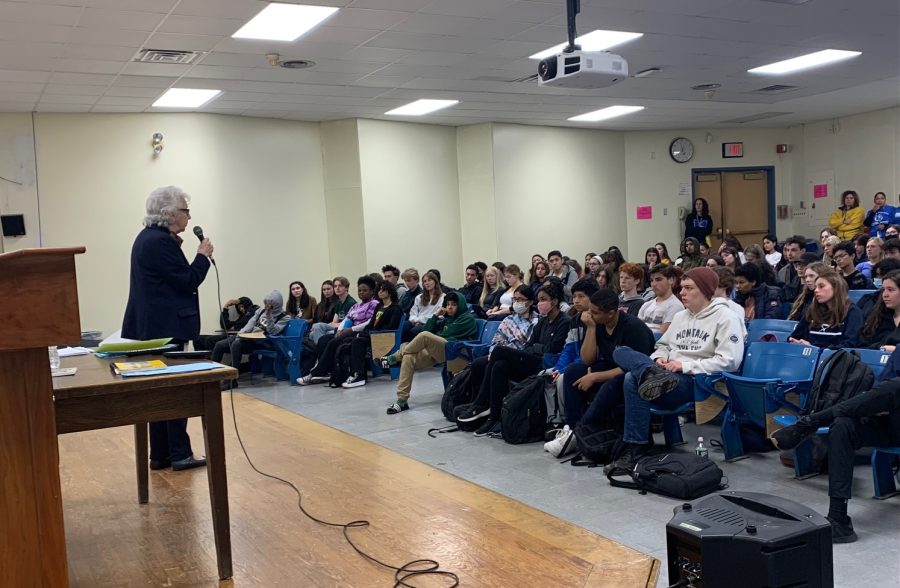Holocaust survivor Maud Dahme shares her experience with MHS students
May 8, 2023
 Maud Dahme, a “hidden child” of the Holocaust, shared her experiences during World War II with Montclair High School on Friday, April 28.
Maud Dahme, a “hidden child” of the Holocaust, shared her experiences during World War II with Montclair High School on Friday, April 28.
The 87-year-old said she was inspired to share her story after a segment on “60 Minutes,” some forty years after her rescue. Dahme underscored the importance of relaying personal accounts to combat antisemitic rhetoric and Holocaust deniers.
As a six-year-old, Dahme was hidden by the Dutch resistance, a movement of people in the Netherlands who opposed Hitler’s regime. They worked to hide and shelter Jewish people.
“They said Jews were not exterminated in gas chambers. Gas chambers were wartime propaganda fantasies,” Dahme said. She maintained it is her duty, as a survivor, to share her story and stop the spread of misinformation about the Holocaust.
Dahme started school when the Nazis began invading Europe, but her early childhood would be consumed by war.
“I loved going to kindergarten. I loved my teacher. I loved going to school, but that didn’t last very long either,” Dahme said. A few months after the school year began, all Jewish people older than five were required to wear a yellow star that read Jood, the Dutch translation of Jew.
“I was so excited. I got to wear the star, but my sister was only four years old [and did not need the marking],” Dahme said. “I’m such a big girl [she thought].”
Not long after Dahme started school, Jewish children were banned from public schools and required to attend Jewish school.
Dahme described how the Nazis moved quickly through the country and how Jews soon found themselves stripped of their former rights of citizenship. Everyone was confused, there was a meeting held at the local synagogue, but no straight answer was given, Dahme explained.
“My parents snuck into their [Christian] friend’s house so they could know what was going on,” Dahme said. There, they learned Case, [their] friend, was working for the Dutch resistance, and he had an address for the placement of Maud and her sister.
“She [Maud’s mother] said I have such great news for you. You are going on a vacation to a farm,” Dahme said. “Maud, take very good care of your sister. We will see you in a couple weeks.”
Once they arrived at the farm, Maud and her sister had to walk in the woods to get to the safe house. Only Maud received flashlights.
“I’m such a big girl now,” Dahme said of her feelings of responsibility. “My sister started to cry. She wanted her mommy. I didn’t know what to do.”
Once they arrived at the safe house, Maud and her sister received different names and were told that the adults they were living with were their aunt and uncle.
“If I didn’t remember this properly, they were going to take us away — my sister and I — and kill us, and they [aunt and uncle] would be killed too,” Dahme said.
Despite the existential threat of war, Dahme and her sister maintained the innocence of children. Dahme kept her own collection of spent ammunition that she picked up off the ground and hid in the safe house for play. When the war was over, she showed her father who revealed that it was actually live ammunition.
After hiding on the farm, German soldiers became aware of the two sisters, so they were relocated to a fishing village.
“It was the hunger winter. There was nothing to eat,” Dahme said. “But my sister and I fit in perfectly — we wore the clothes, we spoke the dialect.” After a few months in the fishing village, the Allied forces invaded Normandy.
“They have broken through. They’re coming, they’re coming. I remember that. I was so excited,” Dahme said. On April 19, 1945, Canadian troops came into the fishing village to free the hidden Jews.
“They’re throwing out chocolate. I didn’t know what this brown thing was. I broke off a piece and shoved it in my mouth, and I went ohhh I love chocolate,” Dahme said. With an ironic nod to her hard-earned, sweet liberty, Dahme titled her 2015 memoir Chocolate, the Taste of Freedom: A Holocaust Memoir of a Hidden Dutch Child.
After the tanks left, Dahme and her sister would wait to see if their parents had also survived.
For three years, Dahme’s parents survived in the attic of their friend’s home, under the same roof as two German officers who had taken residency in the bedrooms.
In the summer of 1945, Dahme and her sister were reunited with their parents. “I remember standing in the pump room… a man and a woman [were] standing in the other doorway,” Dahme said. “I don’t know who they are [I said]. Aunt gave me a shove and said, That’s your mommy and daddy, go shake their hands.”
“I said, we’ll go home with you. If we don’t like you, we will come [back] and live with Aunt,” Dahme said. “I was nine years old. I guess I was a smart mouth then.”
The rest of Maud’s family perished at Sobibor, a concentration camp in Poland.
“We had nothing, just the clothes on our back to start our lives again,” Dahme said. “I had to start school. I’m nine and a half years old. I’ve never been to school. Everyone made fun of me and my sister because we spoke this dialect, not the right Dutch.”
When she was 14, Maud’s family moved to the United States, where she and her sister learned English in a movie theater the summer before attending school. She was originally put in first grade, but she was able to test out and graduate with other children her age.
“My mother, till the day she died, never knew what me and my sister went through. Never asked, never knew,” Dahme noted. But as she became an adult, Dahme knew other generations needed to hear stories like hers.
Dahme published her memoir with the help of her grandson, Hogan Laskey, and the Holocaust Resource center at Stockton University. She remains an active member of the New Jersey Commission of Holocaust Education.

